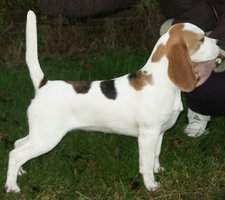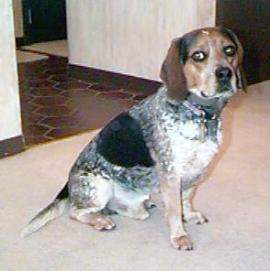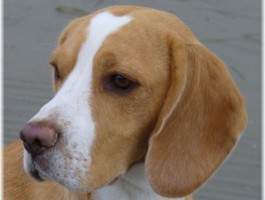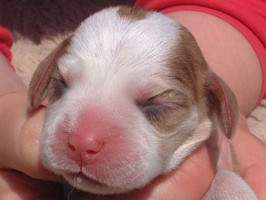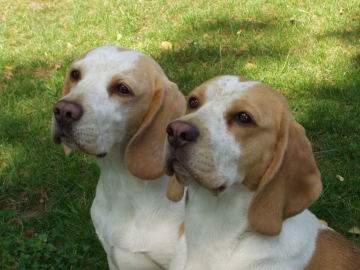Hound colors
The color of a beagle should be "any true hound colour" in the US, in most other countries it is "any true hound color" except liver because of the light yellow eyes that go with the color. The tip of stern has to be white. The "classic" beagle is the tricolor black-tan-white, and when the German Beagle Club started the people that wanted to buy a puppy only knew the tricolors.
We're glad to see a range of colors in the ring nowadays.
The extension of color could be all one color (apart from the white tip of tail). No breed apart from the other similarly marked packhounds allows such a range of colors and even without restricting it to special areas of the body.
The tricolors
The tricolors are usually black, tan and white. The black can be a shining black that will stay up to the age or the black will fade out until the dog gets older. The tan can vary from red to pale tan. The white will be pure white if it's not a mottle (on a mottle it's more cream). The other form of the tricolors are the blue-fawn-whites. Blue is caused by the dilution gene (d for dilute) which lightens black (D for density) into blue, tan into fawn and liver to lilac. The "Blue" correctly described is the grey color of the Great Dane. The tricolor puppy is born black and white, some with brown markings near the eyes and ears, the blue-fawn-white blue and white.
The blue-fawn-whites (or blue tricolor)
The so called "blue mottled" is caused by a totally different gentic background. The blue effect is caused by spots of black hairs within the white coat. All the blue-fawn-whites in Germany go back to Graadtre's Hot Pursuit of Rossut.
The tan color of the dog will develop on the head, hind and foreleg as the dog gets older.
Some puppies show white hairs at the age of eight weeks. These hairs are only seen in a puppy coat.
The bicolors
The bicolors have the two colors brown and white, called lemon, tan and red, regarding the density of the pigment of the coat. Some beagles have a rich tan clour and are called orange.
The puppies are born white with creme markings, which darkens as the puppy gets older. On a puppy it is sometimes hard to tell which color the dog will develop when it gets older, so in the German Beagle Club they are registered as "bicolor". (In Austria we fix the colors by the litter controll, the puppies are registered lemon/tan/red-white). Most of the bicolors end up as tan, some are red, only a few are lemon. The lemons look white when they are born, their nosepigment is the darkest of all three.
Usually the darker the coat pigment the lighter the color of the nose. We like the dark nose pigment but regarding the genes the red-whites cannot have a real dark nose. The color of the nose even varies with the hormonal cycle of the bitch.
lemon-white / tan-white / red-white / fawn-white (the color of a bicolor with the effect of the dilution gene (d), the dilution gene will lighter eyes as well)
The (hare)pieds
The pieds are called, lemon-pied, hare-pied and badger-pied, most of them are hare-pied. On a pied the one hair itself has different colors (should be the agouti-gene). The tip of the hair is black. The range of the pied on the body can be from a stripe on the back to the full side of the body. You can always tell a pied by the typical nose, the rims darker and the center part paler (some call ist a "butterfly-nose"). The pied puppies look when they are born like the bicolor pups with dark eye rims. When the dog gets older the pied stripe on the back can fade out so that one can only identify the pied by the butterfly-nose.
There are still judges that don't know about the harepied colors and disregard the dog with "wrong nose pigmentation" The harepied beagles in Germany go back to the "Korwin" beagles of Christine Watson in Scotland. They were brought to Germany by Bärbel Röllinghoff of "Bar Atlantic".
The mottles
The mottle color used to be the color of the pack hounds, these dog lacked the quality of a show beagle. Some British beagle breeders wanted to save the color and brought it into the show beagle scene. Well known for his mottles was Davis Nicolsen with his "Sabinhay"beagles. In Germany the first were bred by Ulla Christian, kennel "vom Kemnader See".
A mottled beagle has little spots of dark hair on the white areas of his coat. The white of a mottled is never a pure white but a pale cream. The mottled is called after the origin coat color, e.g. lemon-, tan- or red-mottled and blue-tan-white-mottled. There could be a misunderstanding, what is a blue mottled, the blue-tan-white-mottled or the blue-mottled shown earlier. You can tell a mottled puppy by the paws. Within the first week it will show the pigmentation of the paw starting on the edge of the paw, looking like rings later.
The livers
The gene for the color liver changes the black pigment (B) into brown (b). It is a recessive gene so it will never disappear completely. The liver (and also lilac) color is not allowed by the official beagle standard because of the light eyes that go with the coat color.
Breeding colors
The allel series is tricolor -> pied -> bicolor, so tricolor is dominant over pied, wich is dominant over bicolor
homozygote tri x tri or pied or bi = all tri
heterozygote tri x heterozygote tri = tri, bi or pied
heterozygote tri x bi = tri, bi or pied
heterozygote tri x homozygote pied = tri and pied
heterozygote tri x hetrozygote pied = tri, bi or pied
homozygote pied x bi = all pied
hetrozygote pied x bi = pied or bi
homozygote tri x homozygote tri = all tri
homozygote pied x homozygote pied = all pied
bi x bi = all bi
The mottled gene is dominant over the non mottled gene.
homozygote mottled x mottled or non mottled = all mottled
heterozygote mottled x hetrozygote mottled = mottled or non mottled
heterozygote mottled x non mottled = mottled or non mottled
non mottled x non mottled = non mottled
Intense color (D) ist dominant , diluted color (d) is recessive.
Black (B) is dominant, liver (b) is recessive.
The brindle
The brindle is not a true hound color for a beagle. It appeared in Sweden about 30 years ago near the Norwegian border. It is the result of a mixture with another breed, supposed to be a mixture with a Drever, s short legged Swedish breed. The brindel gene is dominant and so it's easy to select within the population.
Autor: Dr. Kristin Schröder
Photos:
V. Bradley UK, S. Parker UK, C. Linde-Forsberg S, J. Holmes US, I. Koch A,
U. Christian, A. Derscheid, S. Jarosch, Fam. Janowski, Fam. Rodorf, A.Schulz, S. Kipp, K. Sonntag

